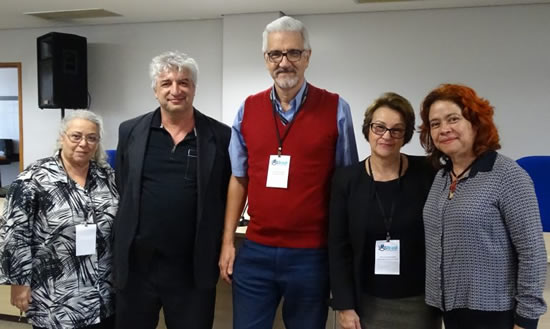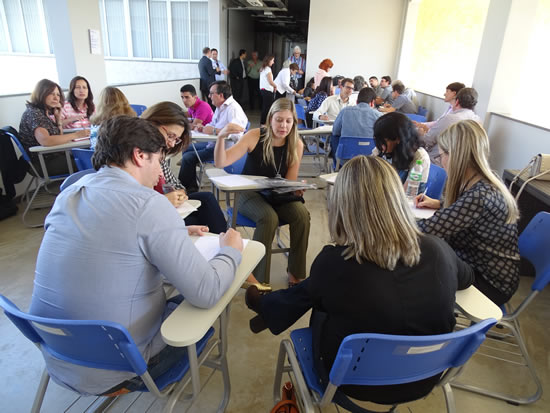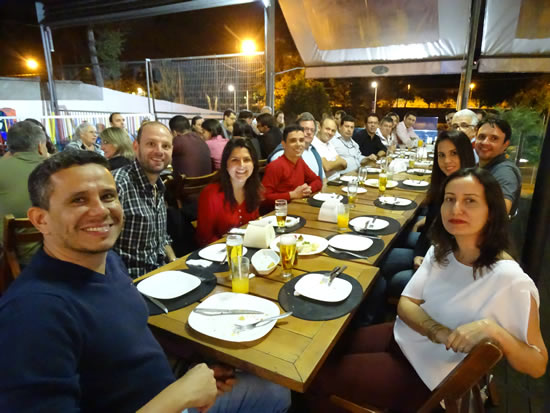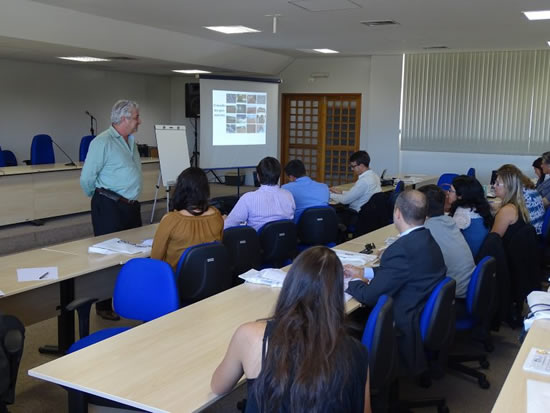



By Bruno Pedroni – During the last days of July, when many in Brazil are typically on vacation, more than 50 people gathered for the IGS Educate the Educators geosynthetics program at the Federal University of Minas Gerais (UFMG) in Belo Horizonte (MG). The program, which was the first of its kind in the country, was held July 27 – 29.
Educate the Educators is a program developed by the International Geosynthetics Society (IGS).
The participating professors in Brazil—32 in all—represented public and private universities from 12 states. Lectures were provided by nationally and internationally renowned instructors: Delma Vidal (ITA), Enio Palmeira (UNB), Jorge Zornberg (University of Texas at Austin), and Maria das Graças Gardoni (UFMG).
Gold level sponsors for the event included HUESKER, Geo Soluções, Braskem, TDM Brasil and Maccaferri. Silver level sponsors included Engepol and Inovageo.
BASIS FOR THE WORKSHOP
The program has been designed to move geosynthetics into engineering programs and related disciplines, said IGS Brazil chairman André Estevão. The need is clear. Despite the expansion of geosynthetics throughout all major infrastructure sectors over the past 40+ years, many programs do not yet have any geosynthetics information in their curricula. Educate the Educators empowers them to do so.
Over three days, participants learned from example lectures on various topics of geosynthetics, case studies, educational discussions, and practical workshops. Dr. Jorge Zornberg (IGS Immediate Past President and engineering professor at the University of Texas at Austin) emphasized the consistency and quality of all presentations, including industries presentations which complemented the theoretical content.
“The workshops were even better than I imagined they would be, ” said Dr. Maria das Graças Gardoni (UFMG), who helped develop the Brazilian edition over the past two years. “The first workshop was very good but the second was great because it led discussions. It’s a different way of teaching. It’s lighter. It motivates students to get involved in the discussion. In the first workshop, they might have had contact with geosynthetic samples; but in the second, they went into the field, to the work, and made the link between the knowledge that was acquired in class and that which is acquired in the practice. We have created workshops that make the experience richer and more interactive. The result is very gratifying to me, as a manager of the project. ”
One of the clear objectives of the program is to show how teachers in their classes can address the properties and functions of geosynthetics. This objective involves not only reaching required engineering classes but elective courses and certain related topics.
EDUCATE THE EDUCATORS TESTIMONIALS
“I really enjoyed this opportunity because we need that support from renowned teachers to broaden our knowledge on geosynthetics and teach our students safely, ” said Kenia Parente Lopes Mendonça (Catholic University of Tocantins), one of the teachers who participated in the program. “In our state, Tocantins, we have to overcome unfamiliarity or distrust of geosynthetics. We must present case histories and show people how and why they should study and use geosynthetics. These materials will be as important (in the state) as steel and concrete. I believe that with this kit of samples, the model presentations, and the Brazilian Manual of Geosynthetics, we can teach students more about the topic in an interactive way. ”
Victor Pereira Faro, a professor at the Federal University of Paraná, said that he had incorporated geosynthetics in his curriculum but now believes that his approach should be more conceptual. “I will try to captivate and motivate students regarding the use of geosynthetics, ” he said.
“The experience was excellent, ” said Dr. Zornberg. “Importantly, IGS Brazil has in its membership a large very committed group of academic and industry representatives. We saw these two parts working together [during the program]. They offered a lot, especially to the young scholars who are just now learning about geosynthetics.”
IGS Brazil received strong and encouraging feedback from the participants. It believes it has met the objectives set for the program by the IGS and IGS Brazil stakeholders. The chapter is now reviewing the results from the July program and looking to the future.
“Now we have to start thinking about the next one,” said IGS Brazil chairman André Estevão. “The experience was very positive. This first Brazilian edition was as if we were doing the 12th.”
Bruno Pedroni is the Editor of Geosynthetica.net.br, the Portuguese-language, Brazilian market website of Geosynthetica. He can be reached at bruno@geosynthetica.net.
SEE ALSO: IGS Educate the Educators Succeeds in Texas











